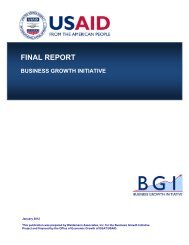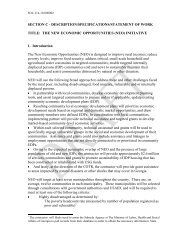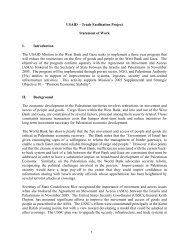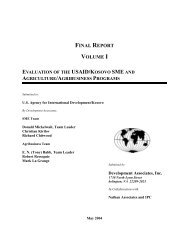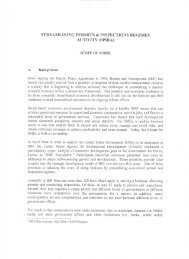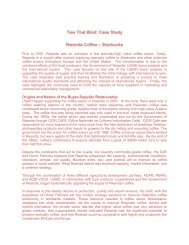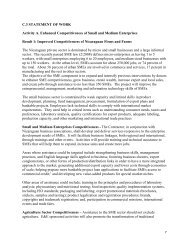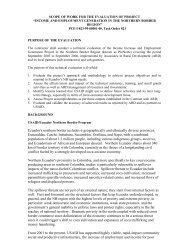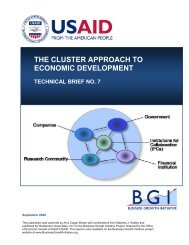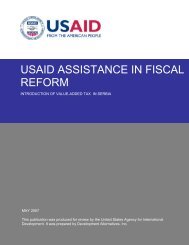Property Tax Reform in Developing and Transition Countries
Property Tax Reform in Developing and Transition Countries
Property Tax Reform in Developing and Transition Countries
You also want an ePaper? Increase the reach of your titles
YUMPU automatically turns print PDFs into web optimized ePapers that Google loves.
<strong>and</strong> churches), <strong>and</strong> perhaps properties of low value. Other exemptions tend to be politically driven, erode<br />
the tax base substantially, <strong>and</strong> <strong>in</strong>troduce an unfairness to the system. Arguably the most problematic of<br />
the preferential treatments is that given to owner-occupiers, <strong>and</strong> to government properties. These issues<br />
are too sensitive to warrant a blanket recommendation to discont<strong>in</strong>ue them, but best practice might dictate<br />
the follow<strong>in</strong>g actions:<br />
<br />
<br />
<br />
Place a “sunset clause” on all exemptions. Make renewal dependent upon a successful<br />
evaluation. At a m<strong>in</strong>imum, <strong>in</strong>stitute a periodic review of property tax exemption policy with<br />
the goal of determ<strong>in</strong><strong>in</strong>g whether exemptions cont<strong>in</strong>ue to serve their <strong>in</strong>tended purpose.<br />
Adopt the practice of valu<strong>in</strong>g all property, whether taxable or exempt, <strong>and</strong> publish an annual<br />
tax expenditure note for the property tax quantify<strong>in</strong>g the revenues foregone from exemptions<br />
<strong>and</strong> other reliefs.<br />
Charge a payment <strong>in</strong> lieu for government properties <strong>and</strong> for relevant non-profit uses of<br />
property, to reflect or approximate their use of local services.<br />
Fifth is the question of how poor families should be treated under the property tax. There is some rough<br />
justice <strong>and</strong> probably little revenue loss <strong>in</strong> exempt<strong>in</strong>g low-valued properties. But, the case for provid<strong>in</strong>g<br />
preferential treatment for pensioners or for larger family sizes would seem less easily justified.<br />
Sixth, best practice shows that all four steps <strong>in</strong> property tax adm<strong>in</strong>istration (identification of properties,<br />
valuation, recordkeep<strong>in</strong>g, <strong>and</strong> collections) must be part of any adm<strong>in</strong>istrative reform program. To leave<br />
out even one of the basic pillars of adm<strong>in</strong>istration may jeopardize the success of a property tax reform,<br />
whether <strong>in</strong> terms of revenue mobilization or any other objectives the reform was designed to achieve.<br />
Seventh, a key step <strong>in</strong> adm<strong>in</strong>istrative reform is to br<strong>in</strong>g all properties on to the tax roll. Partial coverage is<br />
a major problem <strong>in</strong> many develop<strong>in</strong>g <strong>and</strong> transition countries. There are two ways to move toward the<br />
goal of full coverage: (i) <strong>in</strong>stitute a GIS <strong>and</strong> tax mapp<strong>in</strong>g system for identify<strong>in</strong>g properties; <strong>and</strong> (ii) adopt<br />
a unique parcel ID number<strong>in</strong>g system <strong>in</strong> order to l<strong>in</strong>k the various l<strong>and</strong>, build<strong>in</strong>g <strong>and</strong> property tax records.<br />
Eighth, concentrate adm<strong>in</strong>istrative resources on improv<strong>in</strong>g the ratio of assessed to market value of<br />
property. In some cases, this will require strengthen<strong>in</strong>g a weak staff <strong>and</strong> revamp<strong>in</strong>g antiquated<br />
procedures. In other cases, it will require overcom<strong>in</strong>g the lack of political will <strong>in</strong> government—for<br />
example, when the government resists or delays efforts to revalue properties as required by law.<br />
<strong>Reform</strong>ers should proceed slowly until the local government shows its resolve to remove such constra<strong>in</strong>ts.<br />
N<strong>in</strong>th, remove or reduce the <strong>in</strong>centive to under declare the value of property transactions which results<br />
from the imposition of a property transfer tax. One way to do this is to reduce the transfer tax rate to a<br />
low level <strong>and</strong> put <strong>in</strong> place a workable system to challenge <strong>and</strong> overturn under-declarations of sales values.<br />
Another is to abolish the transfer tax <strong>in</strong> favor of a capital ga<strong>in</strong>s tax on l<strong>and</strong> transfers.<br />
Tenth, adopt any reasonable measures to raise collection rates, especially <strong>in</strong> low <strong>in</strong>come <strong>and</strong> transition<br />
countries where collection rates tend to be miserably low. A more horizontally equitable tax structure can<br />
contribute to this by remov<strong>in</strong>g preferential treatments. This will give taxpayers a sense that the property<br />
tax is fair, <strong>and</strong> might even <strong>in</strong>crease property owners’ will<strong>in</strong>gness to pay. Furthermore, reduc<strong>in</strong>g<br />
compliance costs—for <strong>in</strong>stance, by establish<strong>in</strong>g collection po<strong>in</strong>ts at banks or neighborhood offices—can<br />
also go a long way to <strong>in</strong>creas<strong>in</strong>g compliance <strong>and</strong>, ultimately, collection rates. But still, the major route to<br />
<strong>in</strong>creas<strong>in</strong>g the collection rate is for the local government to enforce the tax accord<strong>in</strong>g to the provisions<br />
given <strong>in</strong> the law. Aga<strong>in</strong>, it is a question of the will of the government to establish a strong, susta<strong>in</strong>able<br />
property tax.<br />
v



